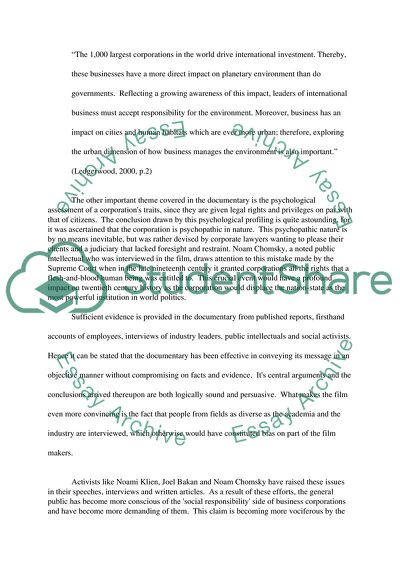
- Home
- Free Samples
- Premium Essays
- Editing Services
- Extra Tools
- Essay Writing Help
- About Us
- Studentshare
- Subjects
- Miscellaneous
- DOCUMENTARY
DOCUMENTARY - Essay Example

- Subject: Miscellaneous
- Type: Essay
- Level: Masters
- Pages: 4 (1000 words)
- Downloads: 0
- Author: russellinnie
Extract of sample "DOCUMENTARY"
This thesis is suitably demonstrated in the documentary through a compilation of interviews, film clips and case studies from the past. Divided in three one-hour episodes, the documentary succeeds in showing to the viewer the various negative aspects of a business corporation, which often gets little attention in the mainstream media and popular discourse. One of the major themes of the documentary film is the damage done to the environment by large business corporations. With commercial profitability being their primary motive, many large corporations neglect to address the negative impact on the environment.
For example, many paper mills in the U.S.A dump toxic affluents from their processing plants into the nearby stream or river, causing irreparable damage to the local ecosystem and also increasing risk to human beings. The other criticism levelled against corporations is their tendency to exploit cheap labor in Third World regions. A classic example of this is the substandard wages paid to workers of Nike in Indonesia, who get less than one percent of the marked price of the goods they manufacture.
Another well-publicized case is that of Monsanto corporation, which introduced into the market a bovine hormone injection which had proven unsafe for both animals and humans during the testing stage. Cognisant of this risk factor, Health Canada had banned the injection in Canada – a move that was repeated in many European countries as well. Only in the United States was the injection allowed to enter the markets, which eventually caused much suffering for the animals and put the safety and wellbeing of consumers at risk.
In the case of Monsanto, the Fox News network refused to broadcast an investigative story about the company due to fears of loss in advertisement revenue. The essence of this situation is concisely written by Grant Ledgerwood in his book Environment Ethics and the Corporation as
...Download file to see next pages Read More
- TERMS & CONDITIONS
- PRIVACY POLICY
- COOKIES POLICY